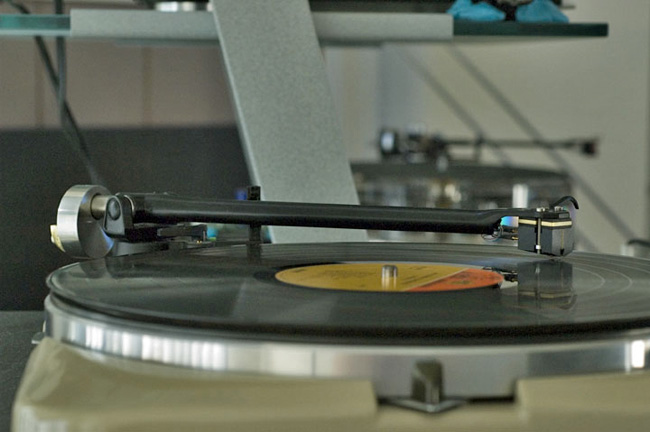-edible zone-
Matching the needs of the Denon DL-103R MC phono cartridge to the
RB250 tonearm as modified by Express Machining. The Expressimo RB250.
Some would say that the optimal tonearm for the vintage Denon DL103
mc phono cartridge is the SME 3012. Why? Who knows, maybe that's what
Denon initially tuned their cartridge to work on back in 1962. Just
guessing. The 12 inch SME series 2, with its aluminum arm tube, has an
effective mass rating of 14g. The earlier series 1 SME featured a
stainless steel arm tube. Its effective mass rating isn't known to me
but has to be heavier than the later aluminum tube model.
This
would explain the Denons' robust cantilever spring with its rather stiff
compliance. Like any heavier spring, it was intended to carry a greater
weight load. Modern tonearms tend to have effective mass ratings in the
medium range; 10 to 13grams. If my thinking is right, and If we use the
Denon on one of these lighter arms, the cantilever will be too stiff for
the arm, tracking won't be optimal and sound quality won't be what the
Denon engineers intended.
With these things in mind I decided to
make a little experiment to add mass to the Expressimo tonearm, with its
10gram effective mass rating, to better approximate the needs of the
Denon. I made a headshell weight out of constrained layers of solid
brass plate sandwiched between outer plates of carbon fiber.
*
Additional weight over the cartridge: 7.5 grams. This would be mounted between the cartridge and tonearm out on the business end. To balance this extra mass, additional weight had to be added to the counterweight. Call it extra ballast. It took an additional 25 grams of ballast on the counterweight to balance the additional weight at the headshell.
4 plates of .0625 inch thick brass are bolted to the Expressimo counterweight. (note: detail photo is gone.)
*
With Vertical tracking force set to 2.5 grams, the HFNRR test record was used to measure arm/cart resonance in the lateral plane of motion. The arm shook most violently at 11 to 10 hz but showed lesser vibration at 13hz and 9 hz. My records indicate that previous arm/cart resonance measurements taken without the extra weights resulted in max resonance in the 11 - 12hz range. So it took 7.5 grams additional weight over the cartridge to lower the resonant frequency by a full hz. Interesting.
Let's keep in mind that my measurement is well within the optimal range for arm/cart resonant frequency of 8 to 12hz. 'could even add more and adjust to 10-9hz
Setup:
VTF, as noted above, is set to 2.5g. VTA is adjusted for optimal
sound quality. Note that this older design cartridge, the 103, has a
built-in vta of 15 degrees off the horizontal plane. Most later records
were cut on lathes with a vta setting of 22 degrees. Hence, with the
Denon, optimal VTA will be found with the cartridge seen in a slightly
nose-down orientation to match the needs of the record. Earlier 50's Lps
will sound better at 15 degrees. Sixties and later records will want 22
degrees to lock in best sound quality. Anti-skate was set to 2 grams
using the scale on the Rega.
Listening:
An immediate
difference is heard. Music seems to have finer detail. More fine inner
details. But the most apparent difference is a more liquid flow to the
music. Smoother. More refined. Apparently this was a step in the right
direction.
Conclusion:
This experiment was made just to
prove out a hunch of mine, that the Denon requires a heavier tonearm to
sound its best. Also, there is a current practice of removing the Denon
from its plastic shell and replacing it into denser, heavier exotic wood
bodies. I'll be trying one of these (Ebony) in the days to come and
wanted to differentiate between the sound differences caused by heavier
mass versus any resonant qualities of the Ebony body and removal of the
plastic body.